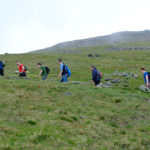1914 was a year of continual innovation in technology. Here we present some of 1914’s most interesting scientific and technological advances, as we look forward to the New Year almost a hundred years later on.
The space rocket is patented
The concept of the space rocket has been around for centuries, ever since Chinese warriors experimented with “fire arrows” hundreds of years ago. However, the concept behind the modern rocket was patented in 1914, during a period when scientists were inspired by sci-fi writers such as HG Wells and Jules Verne. Physicist Robert Goddard spent two years, from 1912 to 1914, working on the idea of a rocket designed with separate stages, a separate combustion chamber, and with greatly increased exhaust speed.
When Goddard published his results in 1920, he even made reference to sending a rocket to the moon. A New York Times editorial called this idea “absurd” and stated that Goddard “seems to lack the knowledge ladled out daily in high schools”. Read more on the NASA website.
Air conditioners arrive in the home
Once again at the forefront of technology, the Chinese nation was the first to introduce mechanical air cooling. Most of their ideas were based on rotary fans operated by water or manual labour. From the 18th century onwards, Europeans and Americans experimented with various devices for mechanically cooling air, followed by an electrical air cooling machine invented in Buffalo, New York, in 1902.
Air conditioners were included in a private home for the first time in 1914, when a unit measuring seven feet high by six feet wide was installed in a mansion in Minneapolis. Air conditioning remained the preserve of the wealthy for decades, despite the invention in 1931 of the conventional window ledge unit that we still see today. These cost a minimum of $10,000 ($120,000 in today’s money) when they were launched in 1932. Read more on the Popular Mechanics website.
Mechanised vehicles are introduced to the battlefield
The concept of the tank has been conceived by figures as diverse as Leonardo da Vinci and HG Wells, but mechanised vehicles first made their appearance on the battlefield in 1914. World War I saw the mechanisation of warfare in many different areas, including the tractors which replaced horses in dragging supplies through muddy terrain.
The tractors were the inspiration for the battle tanks that appeared later in the war. In December 1914, a French engineer proposed “a design for a ‘landship’ with armour and armament based on the motorization of a compactor with heavy wheels or rollers”. Meanwhile, in October of the same year, a British Officer, inspired by what he’d seen of the tractors in France, proposed an adaptation that could be used to destroy German artillery. By 1915, the name “tank” had been adopted and, in 1916, the first offensive using tanks took place during the Battle of the Somme. Read more on Wikipedia.
A Jupiter moon is newly identified
A moon, later named Sinope, was discovered in California in 1914 by astronomer Seth Barnes Nicholson. It was the outermost known moon of Jupiter until the discovery of Megaclite in 2000. Sinope is thought to be red in colour and to measure just 38 km in diameter.
In Greek mythology, Sinope is kidnapped by Apollo or Zeus, and in some legends bears a son named Syrus, who became King of the Syrians. Read more on the NASA website.
The Panama Canal opens
One of the world’s greatest feats of engineering, the Panama Canal opened in 1914. Forty-eight miles in length, the canal connects the Atlantic and Pacific Oceans, allowing ships to avoid the lengthy crossing around Cape Horn at the bottom of South America.
Engineers struggled with Panama’s climate and topography, to the extent that the original French attempt to build the canal went bankrupt and cost an estimated 22,000 workers’ lives. The United States acquired the project in 1904 and introduced innovative technology such as giant steam-powered shovels and cranes. When it opened on 15 August 1914, the canal was the largest American engineering project ever undertaken. Read more on Wikipedia.
And some other innovations…
US Congress introduced the country’s first income tax, payable on incomes over $3,000 per year; soldiers from Germany, Russia, France and Britain held the first and only Christmas Day truce in World War I; and the first scheduled airline flight took place from St Petersburg, Florida to Tampa.










